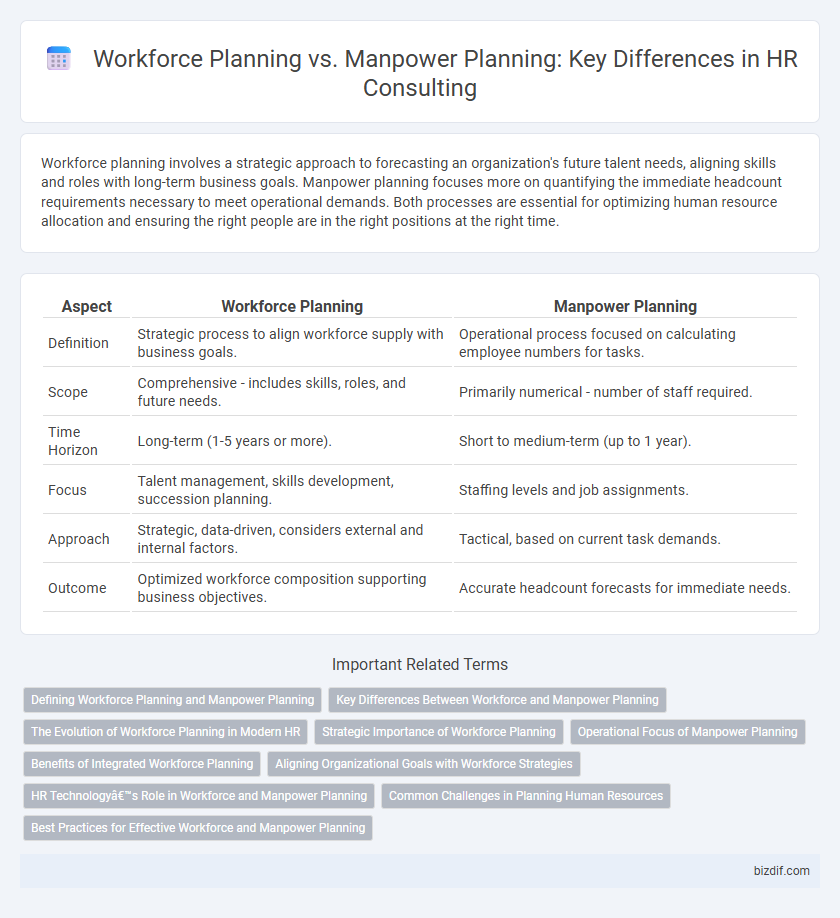Workforce planning involves a strategic approach to forecasting an organization's future talent needs, aligning skills and roles with long-term business goals. Manpower planning focuses more on quantifying the immediate headcount requirements necessary to meet operational demands. Both processes are essential for optimizing human resource allocation and ensuring the right people are in the right positions at the right time.
Table of Comparison
| Aspect | Workforce Planning | Manpower Planning |
|---|---|---|
| Definition | Strategic process to align workforce supply with business goals. | Operational process focused on calculating employee numbers for tasks. |
| Scope | Comprehensive - includes skills, roles, and future needs. | Primarily numerical - number of staff required. |
| Time Horizon | Long-term (1-5 years or more). | Short to medium-term (up to 1 year). |
| Focus | Talent management, skills development, succession planning. | Staffing levels and job assignments. |
| Approach | Strategic, data-driven, considers external and internal factors. | Tactical, based on current task demands. |
| Outcome | Optimized workforce composition supporting business objectives. | Accurate headcount forecasts for immediate needs. |
Defining Workforce Planning and Manpower Planning
Workforce planning is a strategic process that identifies current and future human resource needs to align talent acquisition, development, and retention with organizational goals. Manpower planning, often used interchangeably, primarily focuses on forecasting and supplying the right number of employees with specific skills to meet operational demands. Effective workforce planning integrates broader business strategies, while manpower planning emphasizes quantitative staff requirements and allocation.
Key Differences Between Workforce and Manpower Planning
Workforce planning involves a strategic approach to analyzing, forecasting, and managing talent needs to align with long-term business goals, integrating factors such as skills development, retention, and succession planning. Manpower planning is primarily focused on quantifying the number of employees required to meet immediate operational demands, often emphasizing headcount and labor cost control. Key differences include workforce planning's holistic, future-oriented perspective versus manpower planning's tactical, short-term focus on employee numbers.
The Evolution of Workforce Planning in Modern HR
Workforce planning has evolved from traditional manpower planning by integrating data analytics, predictive modeling, and strategic alignment with business goals to address dynamic talent needs and market changes effectively. Modern workforce planning emphasizes agility, skill gap analysis, and scenario planning, enabling organizations to anticipate workforce demands and optimize talent deployment. This evolution supports proactive decision-making and enhances organizational resilience in a competitive global environment.
Strategic Importance of Workforce Planning
Workforce planning plays a strategic role in aligning talent supply with long-term business goals, enabling organizations to anticipate future skill needs and address workforce gaps efficiently. Unlike traditional manpower planning, which centers on immediate staffing levels, workforce planning integrates data analytics, labor market trends, and organizational growth projections to optimize human capital investments. This proactive approach supports sustainable competitive advantage by fostering agility and informed decision-making in talent acquisition and development.
Operational Focus of Manpower Planning
Manpower planning centers on aligning workforce capacity with immediate operational demands, ensuring optimal staffing levels for daily business activities. It emphasizes scheduling, skill availability, and resource allocation to maintain productivity and minimize downtime. Workforce planning adopts a broader, strategic view, addressing long-term talent management beyond short-term operational needs.
Benefits of Integrated Workforce Planning
Integrated workforce planning combines forecasting, talent management, and resource allocation to optimize organizational efficiency and agility. It enables precise alignment of skills with business objectives, reducing labor costs and minimizing skill gaps. Enhanced decision-making and proactive talent strategies improve employee retention and drive sustainable growth.
Aligning Organizational Goals with Workforce Strategies
Workforce planning integrates long-term organizational goals with dynamic workforce strategies to ensure optimal talent acquisition, development, and retention. Manpower planning traditionally focuses on quantifying personnel needs based on current demand, often lacking alignment with evolving business objectives. Effective HR consulting emphasizes workforce planning as a strategic approach that aligns human capital management with organizational growth, productivity, and competitive advantage.
HR Technology’s Role in Workforce and Manpower Planning
HR technology enhances workforce planning by leveraging advanced analytics, AI, and automation to forecast talent needs, optimize labor costs, and align skills with future business objectives. In contrast, traditional manpower planning often relies on static headcount targets without real-time data integration, limiting agility in responding to dynamic market conditions. Integrating HR tech platforms enables continuous workforce optimization, improved talent acquisition, and effective succession planning, driving strategic human capital management.
Common Challenges in Planning Human Resources
Workforce planning and manpower planning both address aligning human resources with organizational needs, yet common challenges include accurately forecasting demand and supply, managing skills gaps, and adapting to changing business environments. Ensuring data accuracy and integrating technology are critical for effective talent management and succession planning. Overcoming resistance to change and aligning stakeholder expectations remain significant barriers to successful human resource planning.
Best Practices for Effective Workforce and Manpower Planning
Effective workforce and manpower planning require aligning talent supply with organizational demand through data-driven forecasting techniques and scenario analysis. Integrating competency mapping and skills gap assessment ensures optimal resource allocation and enhances employee productivity. Leveraging technology such as HR analytics platforms facilitates continuous monitoring and dynamic adjustment of staffing strategies to meet evolving business goals.
Workforce planning vs manpower planning Infographic

 bizdif.com
bizdif.com